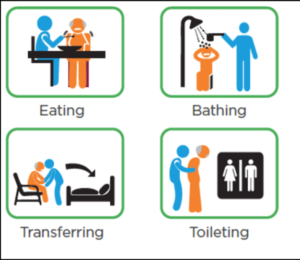Activities of Daily Living

Activities of daily living include mobility, self-care, management of the environment, hardware and devices, communication and home management activities
Daily living activities separated into two areas:
- Basic ADL.
- Instrumental ADL.
Basic ADL include self-care such as bathing, showering bowel and bladder management, dressing undressing etc.
Instrumental ADL include more advance level skill in all performance use of executive function, social skill, and environmental interaction.
Factors to consider in ADL evaluation and training –the therapist must assess performance component and consider several factors like-physical resources; like strength, range of motion, coordination, sensation an balance should be evaluated to determine potential skill and deficits in ADL.
ADL techniques;-the occupational therapist have to explore a variety of methods like dressing activities ,feeding activities ,hygienic grooming ,communication and mobility skill and home management activities.
Recording of progression in ADL performance depends on level of independence those are:
- Independence-can perform the activities without cueing, supervision or assistance with or without assistive devices.
- Partially independent;- minimal -assistance-supervision, cueing, or less than 20 percent physical assistance.
- Moderate assistance-supervision, cueing, and 20 percent to 50 percent physical assistance.
- Maximal assistance-supervision, cueing and 50 percent to 80 percent physical assistance.
- Dependent-can performs only one or two activities independently.
Dressing Activities:
Dressing activities use front opening garment, one size larger than needed and made of fabrics, use dressing sticks with a greater on one end and a neoprene covered coat hook on the other for pushing and pulling garments off and on feet and legs.
- Use larger buttons or zippers with loop on the pull tab.
- Using elastic shoelaces or other adapted shoe fastener.
- Using stocking aids made up garters attached to long webbing straps.
- Use button hooks for fingers ROM, use reachers for picking up socks or shoes.
Feeding Activities:
Build up handles on eating utensils for grasp and prehension, elongated or curved handles on spoons or forks may be needed to reach the mouth, long plastics straws and straw clips on glass. Universal cuff or utensils holder can be used.
- Plate guards or scoop dishes may be useful to prevent food from slipping off the plate.
Hygine and Grooming:
- A hand held shower head on flexible hose for bathing and shampooing hair.
- A long handled bath brush or sponge with a soap holder or long cloth scrubber can be used.
- A position-adjustable hair dryer for those who prefer a hairstyle more elaborate than a simple hairstyle.
- Long handles on comb, brush, toothbrush, lipstick, mascara brush are useful for hand to head or face movement.
- Dressing sticks can be used to pull garments up after using the toilet.
Communication and Environmental Hardware Adaptations:
- Extended or built up handles for limited grasp may be used.
- A clip type receiver holder, extended receiver holder may be necessary.
- Built up pens and pencils for limited grasp and prehension can be used.
- Electric type writers or personal computer can facilitate communication for those with limited or painful joints.
Mobility and Transfer Skill:
- A glider chair that is operated by the feet can facilitate the transportation.
- Platform crutches can prevent stress on hand or finger joints for limited grasp.
Home Management Activities:
- Use reachers to get light weights items.
- Use electrics scissors.
- Use a high stool to work comfortably at counter height for meal preparation .etc.
Check out these links for relevant information: Speech
therapy, occupational therapy
For more details contact
us on 📞9618906780
